LG GR-L218USJA Manual

BOTTOM FREEZER REFRIGERATOR
User’s Guide
Please read this guide thoroughly before operating and keep it handy for reference at all times.
KOMBISKAP MED FRYSEDEL I BUNN
Brukerhåndbok
Les håndboken grundig innen du betjener apparatet og oppbevar den på et tilgjengelig sted for senere oppslag.
KYLSKÅP MED FRYS
Bruksanvisning
Läs denna handbok noggrant innan du använder kylskåpet och spara den för framtida bruk.
KØLESKAB MED FRYSER FORNEDEN
Brugervejledning
Før betjening af enheden bør man læse denne Brugervejledning grundigt igennem og opbevare den på et altid tilgængeligt sted.
JÄÄKAAPPI-
PAKASTIN
Käyttöohje
Lue tämä käyttöohje huolellisesti ennen laitteen käyttöä ja säilytä se helposti saatavilla tulevia tarpeita varten.
P/No. MFL37933533

TABLE OF CONTENTS
English Version |
2 |
Safety Instructions |
3–9 |
Parts and Features |
10 |
Refrigerator Installation |
11–18 |
Unpacking Your Refrigerator |
11 |
Installation |
11 |
Base Cover |
11 |
Removing and Replacing |
|
Your Refrigerator Handles |
|
and Doors |
12–15 |
How to Remove and Reinstall |
|
the Pullout Drawer |
16–17 |
Leveling and Door Alignment |
18 |
Using Your Refrigerator |
19–30 |
Ensuring Proper Air Circulation |
19 |
Multi-Flow |
19 |
Setting the Controls |
19 |
Adjusting the Temperatures |
|
and Display |
20 |
Operating the Dispenser |
21 |
Setting the Functions |
22 |
In-Door Ice Bin |
23 |
Adjusting Control Settings |
24 |
Food Storage Guide |
24 |
Storing Frozen Food |
24 |
Refrigerator section |
|
Refrigerator Shelves |
26 |
Bottle Holder |
26 |
Crisper Humidity Control |
27 |
Removing Crisper |
27 |
Glide‘N’Serve |
27 |
Modular Door Bin |
28 |
Dairy Bin |
28 |
Utility Bin |
28 |
Dispenser Drip Tray |
28 |
Freezer section |
|
Ice Bin |
29 |
DuraBase |
29 |
DuraBase Divider |
29 |
Pull out Drawer |
29 |
Filter |
30 |
Care and Cleaning |
31–32 |
General Cleaning Tips |
31 |
Outside |
31 |
Inside Walls |
31 |
Door Liner and Gaskets |
31 |
Plastic Parts |
31 |
Condenser Coils |
31 |
Power Interruptions |
32 |
When you go on vacation |
32 |
When you move |
32 |
About the Automatic Icemaker |
33 |
Connecting the Water Line |
34–36 |
Troubleshooting Guide |
37–40 |
2

SAFETY MESSAGES
BASIC SAFETY PRECAUTIONS
This guide contains many important safety messages. Always read and obey all safety messages.
This is the safety alert symbol. It alerts you to safety messages that inform you of hazards that can kill or hurt you or others, or cause damage to the product.
All safety messages will be preceded by the safety alert symbol and the hazard signal word DANGER, WARNING, CAUTION. These words mean:
 DANGER
DANGER
 WARNING
WARNING
 CAUTION
CAUTION
You will be killed or seriously injured if you don’t follow instructions.
You can be killed or seriously injured if you don’t follow instructions.
Indicates an imminently hazardous situation which, if not avoided, may result in minor or moderate injury, or product damage only.
All safety messages will identify the hazard, tell you how to reduce the chance of injury, and tell you what can happen if the instructions are not followed.
w DANGER: RISK OF CHILD ENTRAPMENT
Child entrapment and suffocation are not problems of the past. Junked or abandoned refrigerators are still dangerous…even if they will sit for just a few days. If you are getting rid of your old refrigerator, please follow the instructions at right to help prevent accidents.
BEFORE YOU THROW AWAY YOUR OLD REFRIGERATOR OR FREEZER
•Take off the doors.
•Leave the shelves in place so that children may not easily climb inside.
CFC DISPOSAL
Your old refrigerator may have a cooling system that used CFCs (chlorofluorocarbons). CFCs are believed to harm stratospheric ozone.
If you are throwing away your old refrigerator, make sure the CFC refrigerant is removed for proper disposal by a qualified servicer. If you intentionally release this CFC refrigerant, you can be subject to fines and imprisonment under provisions of environmental legislation.
3
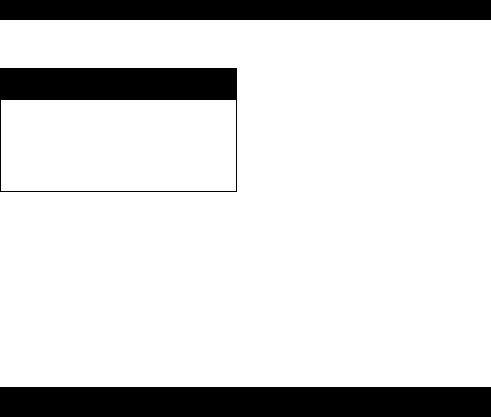
GROUNDING REQUIREMENTS
IMPORTANT: Please read carefully.
TO CONNECT ELECTRICITY
w WARNING
Electrical Shock Hazard
FOR PERSONAL SAFETY, this appliance must be properly grounded. Have the wall outlet and the circuit checked by a qualified electrician to make sure the outlet is properly grounded.
RECOMMENDED GROUNDING METHOD
The refrigerator should always be plugged into its own individual properly grounded electrical outlet rated for 230 Volts, 50 Hz, AC only, and fused at 15 or 20 amperes.
This provides the best performance and also prevents overloading house wiring circuits which could cause a fire hazard from overheated wires.
It is recommended that a separate circuit serving only this appliance be provided.
Use a receptacle which cannot be turned off with a switch or pull chain. Do not use an extension cord.
Where a standard two-prong wall outlet is encountered, it is your personal responsibility and obligation to have it replaced with a properly grounded three-prong wall outlet.
Do not, under any circumstances, cut or remove the third (ground) prong from the power cord.
NOTE: Before performing any type of installation, cleaning,or removing a light bulb, turn the control
(Thermostat, Refrigerator Control or Freezer Control, depending on the model)to OFF and then disconnect the refrigerator from the electrical source. When you are finished,reconnect the refrigerator to the electrical source and reset the control (Thermostat, Refrigerator Control or Freezer Control, depending on the model) to the desired setting.
w WARNING
•Repair or replace immediately all electric service cords that have become frayed or otherwise damaged. Do not use a cord that shows cracks or abrasion damage along its length or at either the plug or connector end.
•When moving your refrigerator away from the wall, be careful not to roll over or damage the power cord.
•Keep fingers out of pinch point areas; clearances between the doors and cabinet are necessarily small. Be careful closing doors when children are in the area.
•This refrigerator must be properly installed in accordance with the Attention Installer Instructions that were taped to the front of the refrigerator.
•Don’t touch the lamp, in case of light on the long time, Because it can be very hot.
•DO NOT refreeze frozen foods which have thawed completely. The United States Department of
Agriculture in Home and Garden Bulletin No. 69 says:
…You may safely refreeze frozen foods that have thawed if they still contain ice crystals or if they are still cold—below 4°C.
…Thawed ground meats, poultry or fish that have any off-odor or off-color should not be refrozen and should not be eaten. Thawed ice cream should be discarded. If the odor or color of any food is poor or questionable, get rid of it.
The food may be dangerous to eat.
Even partial thawing and refreezing reduces the eating quality of foods, particularly fruits, vegetables and prepared foods. The eating quality of red meats is affected less than that of many other foods. Use refrozen foods as soon as possible to save as much of their quality as you can.
SAVE THESE INSTRUCTIONS
4
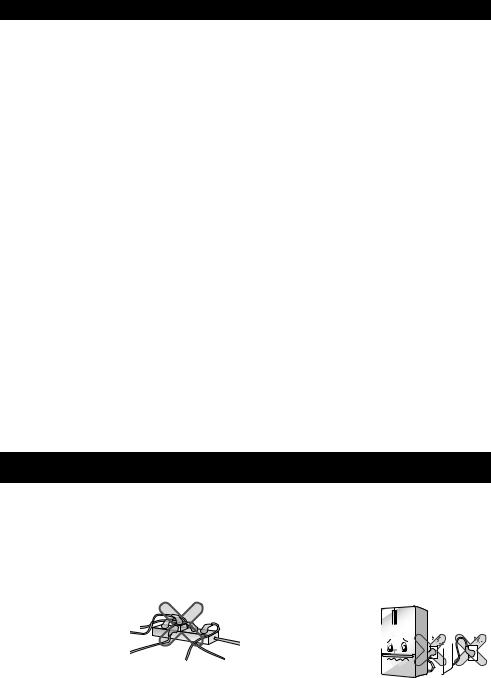
IMPORTANT SAFETY INSTRUCTIONS
Don’t use an extension cord
If possible, connect the refrigerator to its own individual electrical outlet to prevent it and other appliances or household lights from causing an overload that could cause a power outage.
Accessibility of Supply Plug
The refrigerator-freezer should be so positioned that the supply plug is accessible for quick disconnection when accident happens.
Supply Cord Replacement
If the supply cord is damaged, it must be replaced by the manufacturer or its service agent or a similarly qualified person in order to avoid a hazard.
FEED WATER PIPE INSTALLATION
Before installation
•Automatic ice maker can be installed only by manufacturer.
•Automatic ice maker operation needs water pressure of 147~834 kPa (1.5~8.5 kgf/cm2)
(That is, an instant paper cup (180 cc) will be fully filled within 3 sec.).
•If water pressure does not reach the rating 147 kPa (1.5 kgf/cm2) or below, it is necessary to purchase a separate pressure pump for normal automatic icing and cool water feed.
•Keep the total length of the feed water pipe tube within 8 m and be careful for the tube not be bent. If the tube is 8 m or longer it may cause trouble in water feed owing to the drain water pressure.
•Install the feed water pipe tube at a place free from heat.
wWARNING
•Connect to potable water supply only.
•Refer to instructions with water filter kit for installation.
wWARNING
•The refrigerant and insulation blowing gas used in the appliance require special disposal procedures. When disposal, please consult with service agent or a similarly qualified person.
wWARNING
•Please do not use a dishwasher to clean the lower drawers; the high temperature may cause damage to the baskets which make them unusable.
w WARNING
To reduce the risk of fire, electric shock, or injury to persons when using your product, basic safety precautions should be followed, including the following.
Read all instructions before using this appliance.
1. When connecting the power
The dedicated outlet should be used.
• Using several devices at
one outlet may cause fire.
• The electric leakage breaker may damage food and the dispenser may be leaked.
Do not allow the power plug to face upward or to be squeezed at
the back of the refrigerator.
Water may be flown into or the plug may be damaged, which causes fire or electric shock.
5

w WARNING
To reduce the risk of fire, electric shock, or injury to persons when using your product, basic safety precautions should be followed, including the following.
Read all instructions before using this appliance.
1. When connecting the power
Do not allow the power cord bent or pressed by the heavy object to
be damaged.
It may damage the power cord to cause fire or electric shock.
Unplug the power plug when cleaning, handling or replacing the interior lamp of the refrigerator.
•It may cause electric shock or injury.
•When replacing the interior lamp of the refrigerator, make
sure that the rubber ring for preventing the electric spark within the socket is not taken off.
Do not extend or modify the length of the power plug. 
It causes electric shock or fire by the electric damage of the power cord or others.
Do not pull out the cord or touch the power plug with wet hands.
• It may cause electric shock or injury.
Remove water or dust from the power plug and insert it with the ends of the pins securely connected. 
Dust, water or unstable connection may fire or electric shock.
When the power cord or the power plug is damaged or the holes of
the outlet are loosed, do not use them.
It may cause electric shock or short circuit to make fire.
Make sure of grounding.
The incorrect grounding may cause breakdown and electric shock.
Grounding
Conductor
|
|
|
|
|
More than |
|
|
Copper |
|
|
75cm |
|
|
flat |
|
||
|
|
|
|
|
|
6
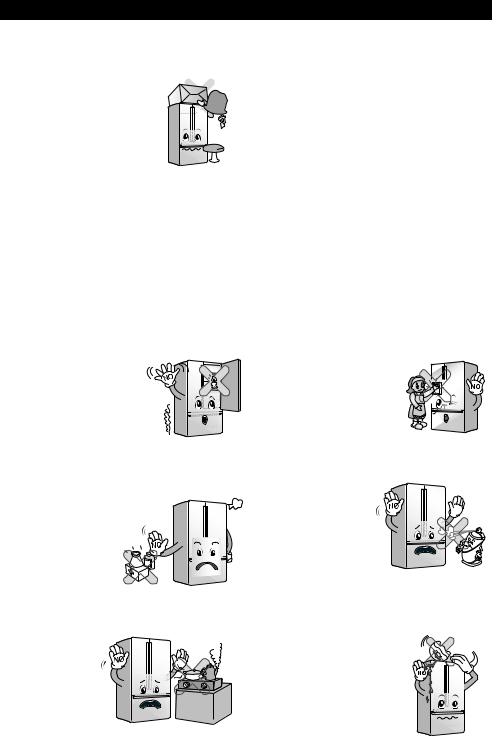
IMPORTANT SAFETY INSTRUCTIONS
2. When using the refrigerator
Do not place the heavy object or the dangerous object
(container with liquid) on the refrigerator.
It may be dropped to cause injury, fire or electric shock when opening or closing the door.
Do not cling to the door or the shelves of the door or the home bar of the freezer or the cool chamber.
It may make the refrigerator fallen down or damage the hands. Especially, do not allow the children to do the above.
Do not place the lit candle within the refrigerator to deodorize.
It may cause explosion or fire.
Do not store the medicine or the academic materials at the refrigerator.
When the material with the strict temperature control is stored, it may be deteriorated or it may make an unexpected reaction to cause any risk.
The Academic
Medicine
The |
Medicine |
Do not install the refrigerator in the wet place or the place which
water or rain splashes.
Deterioration of insulation of electric parts may cause electric leakage.
Do not use or store inflammable materials |
|
||
ether, benzene, alcohol, medicine, LP gas, |
|
||
spray or cosmetics |
|
|
|
near or in the |
|
|
|
refrigerator. |
|
|
|
It may cause explosion |
|
|
|
or fire. |
Benzene |
Ether |
Thinner |
|
|||
Do not insert the hands into the ice bucket or the ice dispenser.
Operating the ice maker may cause injury.
Do not use the combustible spray near the refrigerator.
It may cause fire.
Avoid the heating devices.
It may cause fire.
Do not place flower vase, cup, cosmetics, medicine or any container
with water on the refrigerator.
It may cause fire, electric shock or injury by dropping down.
7
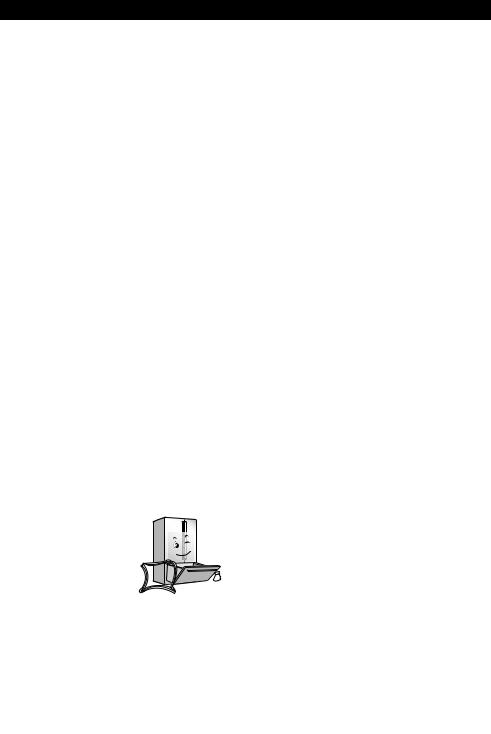
IMPORTANT SAFETY INSTRUCTIONS
2. When using the refrigerator
Use the submerged refrigerator after checking it.
It may cause electric shock or fire.
Do not spray water at the outside or the
inside of the refrigerator or do not clean it |
|
with benzene or thinner. |
|
Deterioration of insulation of |
|
electric parts may cause |
|
electric shock or fire. |
T |
|
hinne |
|
r |
When any strange smell or smoke is detected from the refrigerator, power plug get rid of electric
outlet immediately and contact to the service center.
It may cause fire.
Do not use the refrigerator for non-domestic purpose (storing medicine or testing material, using at the ship, etc.).
It may cause an unexpected risk such as fire, electric shock, deterioration of stored material or chemical reaction.
Do not allow any person except the qualified engineer to disassemble, repair or alter the refrigerator.
It may cause injury, electric shock or fire.
When disposing the refrigerator, remove the packing materials from
the door.
It may cause to lock out the child.
Do not insert the hands or the metal stick into the exit of cool air, the cover, the bottom of the refrigerator, 
the heatproof grill (exhaust hole) at the backside.
It may cause electric shock or injury.
Install the refrigerator on the solid and level floor.
Installing it on the unstable place may cause death by falling down the refrigerator when opening or closing the door.
When you want to dispose the refrigerator, contact to the down-block office.
When you want to dispose |
Down-block |
|
the large living waste such |
||
office |
||
as electric home appliance |
|
|
and furniture, you’d better |
|
|
contact the local down- |
|
|
block office. |
|
8
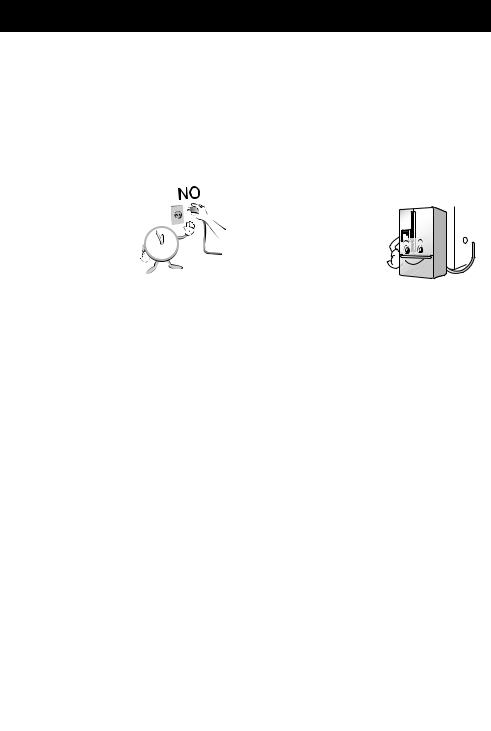
w CAUTION
Violating this direction may cause injury or damage house or furniture. Always be careful, please.
Do not touch food or containers at the freezer with wet hands.
It may cause frostbite.
Do not put ice in thin crystal cup or ceramic ware.
It may break cup or ceramic ware to cause injury.
Wait for 5 minutes or longer when reconnecting the plug.
It may cause the operation of |
|
the freezer to fail. |
After |
|
5minutes |
Pull out the power plug not by grasping the cord but the plug 

of its end.
It may cause electric shock or short circuit to fire.
Do not insert the hands into the bottom of the refrigerator.
The iron plate of the bottom may cause injury.
Because opening or closing the door of the refrigerator may cause injury to the person around it, be careful, please.
Opening or closing the door may cause feet or hands to be caught in the chink in door or the child to be get hurt by the corner.
Do not put any living animal in the refrigerator.
Supply the automatic ice maker with |
|
|
drinkable water only |
|
|
(only for the model |
Drinkable |
|
with the dispenser). |
||
water |
||
|
||
Otherwise, it may cause |
|
|
any risk. |
|
Do not put bottle in the freezer.
It may freeze the contents to break the bottle to cause injury.
Do not install the refrigerator in the wet place or the place
which water or rain splashes.
Deterioration of insulation of electric parts may cause electric leakage.
Carry the refrigerator with the handle bar at the bottom of the front and the top of the rear.
Otherwise, your hands may be slipped to cause injury.
9
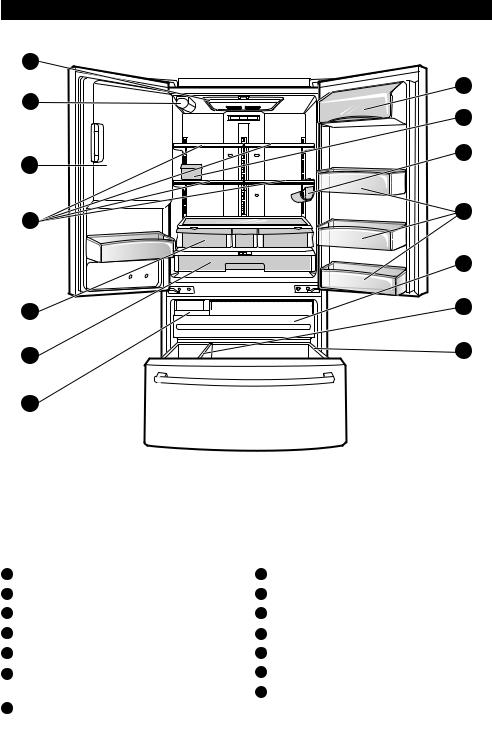
|
PARTS AND FEATURES |
A |
|
|
I |
B |
|
|
J |
D |
K |
|
|
E |
C |
|
|
|
L |
F |
M |
|
|
G |
N |
|
|
H |
|
Use this page to become more familiar with the parts and features. Page references are included for your convenience.
NOTE: This guide covers several different models. The refrigerator you have purchased may have some or all of the items listed below. The locations of the features shown below may not match your model.
A
BFilter (Inside) (p. 30)
CModular Door Bins (p. 28)
DIn Door Ice bin(p.23)
EShelves (p. 26)
Crisper (p. 27)
(Keeps fruits and vegetable fresh and crisper)
G Glide’N’Serve (p. 27)
H Ice Bin (p. 29)
I Dairy Bin (p. 28)
JUtility Bin (p. 28) Bottle Holder (p. 26)
L Pull out Drawer (p. 29)
MDivider (p. 29)
NDurabase (p. 29)
10
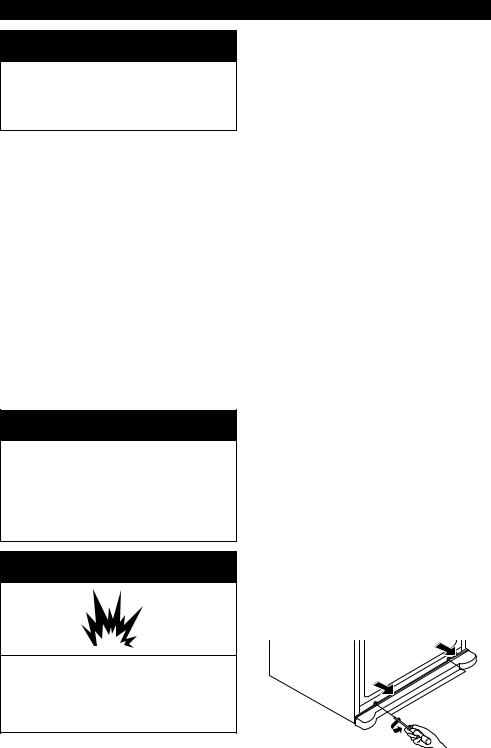
REFRIGERATOR INSTALLATION
w WARNING
Excessive Weight Hazard
Use two or more people to move and install refrigerator.
Failure to do so can result in back or other injury.
UNPACKING YOUR REFRIGERATOR
Remove tape and any temporary labels from your refrigerator before using. Do not remove any warning-type labels, the model and serial number label, or the TechSheet that is attached to back wall of the refrigerator.
To remove any remaining tape or glue, rub the area briskly with your thumb. Tape or glue residue can also be easily removed by rubbing a small amount of liquid dish soap over the adhesive with your fingers. Wipe with warm water and dry.
Do not use sharp instruments, rubbing alcohol, flammable fluids or abrasive cleaners to remove tape or glue. These products can damage the surface of your refrigerator. For more information, see the Important Safety Instructions section.
Refrigerator shelves are installed in the shipping position.
Please reinstall shelves according to your individual storage needs.
w WARNING
When Moving Your Refrigerator:
Your refrigerator is heavy. When moving the refrigerator for cleaning or service, be sure to protect the floor. Always pull the refrigerator straight out when moving it. Do not wiggle or walk the refrigerator when trying to move it, as floor damage could occur.
w WARNING
Explosion Hazard
Keep flammable materials and vapors, such as gasoline, away from refrigerator.
Failure to do so can result in death, explosion or fire.
INSTALLATION
1.To avoid vibration, the unit must be level. If required, adjust the leveling screws to compensate for unevenness of the floor. The front should be slightly higher than the rear to aid in door closing. Leveling screws can be turned easily by tipping the cabinet slightly. Turn
the leveling screws clockwise (  ) to raise the unit, counterclockwise (
) to raise the unit, counterclockwise ( ) to lower it.
) to lower it.
2.Install this appliance in an area where the temperature is between 13°C and 43°C. If the temperature around the appliance is too low or high, cooling ability may be adversely affected.
3.To ensure proper air circulation around the fridge -freezer, please maintain sufficient space on both the sides as well as top and maintain at least 2 inches (5 cm) from the rear wall.
wCAUTION: Avoid placing the unit near heat sources, direct sunlight or moisture.
NEXT
1.Clean your refrigerator thoroughly and wipe off all dust accumulated during shipping.
2.Install accessories such as ice cube bin, drawers, shelves, etc., in their proper places. They are packed together to prevent possible damage during shipment.
3.Let your refrigerator run for at least 2 or 3 hours before putting food in it. Check the flow of cold air in the freezer compartment to ensure proper cooling. Your refrigerator is now ready for use.
wWARNING
•Be careful when you work with hinge, base grille, stopper etc. You may be injured.
•Do not put hands or foot or metal sticks into air vents, base grille or bottom of refrigerator. You may be injured or receive an electrical shock.
BASE COVER
To remove the base cover
1.Open the Freezer Drawer. (Drawer not shown for clarity.)
2.Once drawer is open there is sufficient clearance to remove screws on top of cover.
To replace base cover:
•Place cover into position and insert and tighten screws.
11
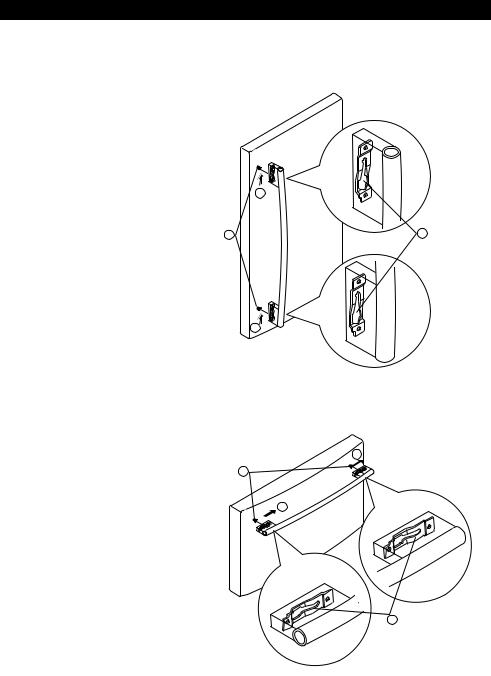
REFRIGERATOR INSTALLATION
HOW TO REMOVE DOOR HANDLES
To move refrigerator through a house door, it maybe necessary to remove the refrigerator door handles.
NOTE: Handle appearance may vary from illustrations on this page.
1.Removing Refrigerator Handle
•Grasp the handle tightly with both hands and slide the handle up (1)(this may require some force).
•The keyhole slots (2) on the back of the handle allow the handle to separate from the mounting screws (3).
wCAUTION: It could be damaged and broken when you hit with hammer while you remove and attach the handle.
wCAUTION: When you assemble or disassemble handle, you must push and pull with moment force.
2.Removing Freezer Drawer Handle
•Press the handle against door first.
•Grasp the handle tightly with both hands and slide the handle to right (1) (this may require some force).
•The keyhole slots (2) on the back of the handle allow the handle to separate from the mounting screws (3).
|
1 |
|
Screws |
Keyhole slots |
|
mounted 3 |
||
2 on back of |
||
on door |
handle |
|
|
1
1
Screws mounted 3 on door
1
2 |
Keyhole slots on |
|
back of handle |
||
|
12

REFRIGERATOR INSTALLATION
HOW TO REPLACE DOOR HANDLES
NOTE: Handle appearance may vary from illustrations on this page.
1.Replacing Refrigerator Door Handle
•Align keyhole slots (1) on the top and bottom of the back of the handle with the screws (2) mounted on the front of the door.
•Press the handle against the door front, making sure that the screws
(2) go into the keyhole slots (1).
•Holding the handle with both hands, press it firmly against the front of the door and slide the handle down (3).
2.Replacing Freezer Drawer Handle
•Align keyhole slots (4) on the right and left sides of the back of the handle with the screws (5) mounted on the front of the drawer.
•Press the handle against the drawer front, making sure that the screws
(5) go into the keyhole slots (4).
•Holding the handle with both hands, press it firmly against the front of the drawer and slide the handle to the left (6).
1
3
2
Screws mounted on door
1
Screws
mounted 6 on door
5
6
4
Keyhole slots on back of handle
13
